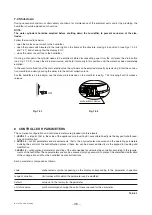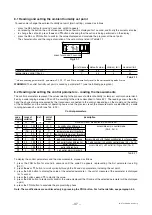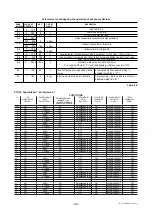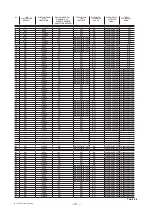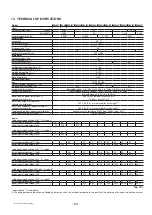
-
47
-
© STULZ GmbH, Hamburg
-
47
-
10 MAINTENANCE AND SPARE PARTS
10.1 Replacing the cylinder
IMPORTANT WARNING: The cylinder may be hot. Allow it to cool before touching it or use protective gloves.
To access the cylinder:
• completely drain the water contained in the cylinder (see par. 7.4);
• turn the appliance off (Fig. 7.4.1) and open the main power switch (safety procedure);
• open and remove the cover (see par. 3.3);
• remove the steam pipe from the cylinder;
• disconnect the electrical connections from the top of the cylinder;
• release the cylinder from its fastening device and lift it up to remove it;
• fit the new cylinder in the humidifier by performing the previous operations in reverse.
Cylinder maintenance
The life of the cylinder depends on a number of factors, including: the complete filling with lime scale and/or the partial or
complete corrosion of the electrodes, the correct use and sizing of the humidifier, the output, and the quality of the water,
as well as careful and regular maintenance. Due to the aging of the plastic and the consumption of the electrodes, even an
openable steam cylinder has a limited life, and it is therefore recommended to replace it after 5 years or 10,000 operating
hours.
IMPORTANT WARNINGS:
The humidifier and its cylinder contain live electrical components and hot surfaces, and therefore all service and/or mainte-
nance operations must be performed by expert and qualified personnel, who are aware of the necessary precautions.
Before performing any operations on the cylinder, check that the humidifier is disconnected from the power sup-
ply; carefully read and follow the instructions contained in the humidifier manual. Remove the cylinder from the
humidifier only after having drained it completely using the corresponding button. Check that the model and the
power supply volta ge of the new cylinder correspond to the data on the rating plate.
Periodic checks
• After one hour of operation
For both disposable and openable cylinders, check that there are no significant water leaks.
• Every fifteen days or no more than 300 operating hours
For both disposable and openable cylinders check operation, that there are no significant water leaks and the general
condition of the container. Check that during operation there are no arcs or sparks between the electrodes.
• Every three months or no more than 1000 operating hours
For disposable cylinders, check operation, that there are no significant water leaks and, if necessary, replace the cylin-
der; for openable cylinders, check that there are no markedly blackened parts of the container: If this is the case, check
the condition of the electrodes, and if necessary replace them together with the o-rings and the cover gasket.
• Annually or no more than 2500 operating hours
For disposable cylinders, replace the cylinder; for openable cylinders check operation, that there are no significant water
leaks, the general conditions of the container, check that there are no markedly blackened parts of the container: If this
is the case, check the condition of the electrodes, and if necessary replace them together with the o-rings and the cover
gasket.
• After five years or no more than 10,000 operating hours
For both disposable and openable cylinders, replace the cylinder.
After extended use or alternatively when using water with a high salt con tent, the solid deposits that naturally form on the
electrodes may reach the stage where they also stick to the inside wall of the cylinder; in the event of especially conduc-
tive deposits, the consequent heat produced may overheat the plastic and melt it, and, in more severe cases, puncture the
cylinder, allowing water to leak back into the tank.
As a precaution, check, at the frequency recommended further on, the deposits and the blackening of the wall of the cylin-
der, and replace the cylinder if necessary.
CAUTION:
Always disconnect the appliance before touching the cylinder in the event of leaks, as current may be passing
through the water.




